PrAACtical Teaching in an ASD Classroom: Bigger is Better with Core Vocabulary
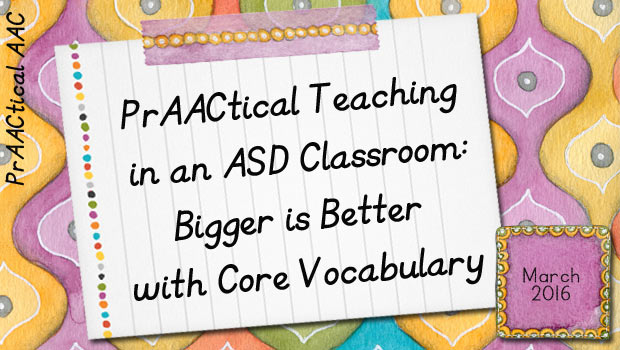
Today we launch a new series, PrAACtical Teaching in an ASD Classroom, which will address the nuts and bolts of infusing AAC throughout the school day. I couldn’t be more delighted to introduce you to two talented special educators, Amy Devin and Lauren Pawlowski, who work in the public school system in Michigan. Amy and Lauren began teaching in self‐contained ASD elementary classrooms in 2009 and taught in resource rooms prior to that.
When they first started with their own classrooms, there was not much talk about core language, let alone how to implement it on a classroom-wide basis. They started with a 32-cell core board on a digitized speech device and now use a 64-location core vocabulary on a manual communication board, large instructional core boards, and individual AAC devices. They are passionate literacy teachers and believe that every child can read, write and communicate. Enjoy their post and video and send them some AAC love at their new blog, Suite Talking, where they write with their colleague (and PrAACtical AAC contributor) Marlene Cummings.
::::::::::::::::::::::::::::::::::::::::::::::::::::::::::::::::::::::::::::::::::::::::::::::::
Bigger is Better with Core Vocabulary
One of the most impactful tools that we use in our classroom is a large classroom core vocabulary board that we fondly refer to as our “Big Core”. We really don’t know what we would do without it. When we were first introduced to core language we started out using Go Talk SGDs with 32 locations and static boards. Very few of our students were augmented otherwise and we relied heavily on those low and no tech options.
In the summer of 2011, we attended a Literacy Academy with Dr. Karen Erickson and Dr. David Koppenhaver that shifted our thinking in many ways. One of the most profound concepts for us 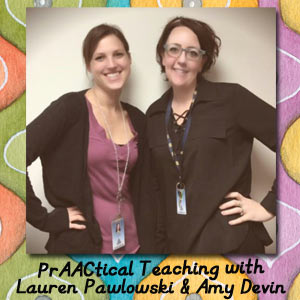 was doing large group instruction in lieu of one on one instruction. They encouraged us to teach our students together and showed us why it would benefit our students as well as our ability to deliver instruction to all of our students.
was doing large group instruction in lieu of one on one instruction. They encouraged us to teach our students together and showed us why it would benefit our students as well as our ability to deliver instruction to all of our students.
Teaching in a group was a big shift for us. We had been doing a great deal of our instruction one-on-one. We were not getting very far because we were not able to give each student enough time with us to make real progress. In a group, students instantly gained hours of instruction they were not getting learning one-on-one.
As we started to think about how we could use core vocabulary to instruct with our curriculum, we realized that we would need to go big or go home. We envisioned a large board, big enough for all of our students to see that would be beneficial for group instruction. When we began utilizing it, we couldn’t imagine all of the benefits we would soon discover. Increased engagement was instant, but these other benefits took longer for us to realize.
- joint and shared attention to language
- large enough for all kids to see visually
- allowed us to model for multiple students (aided language input) at the same time
- allowed students to model for their peers
- shared reading instructional tool
- guided reading instructional tool
- group speech therapy
- easier access for some communicators
- vocabulary instruction during group activities for ALL students. (Even non-AAC users)
- staff and peers can see language modeled
- allows access to multiple presentations of the same core vocabulary for generalization
- multiple turn taking in a group
The possibilities during instruction using this tool are endless, and we soon found ourselves using our Big Core Vocabulary for nearly everything we taught.
If you want to see some big results with Big Core Vocabulary, check out our how to video and get started today!
Direct Link to Video: https://www.youtube.com/watch?v=_ivICrYKkC4&feature=youtu.be
Filed under: Featured Posts, PrAACtical Thinking
Tagged With: classroom, core vocabulary, group, school
This post was written by Carole Zangari
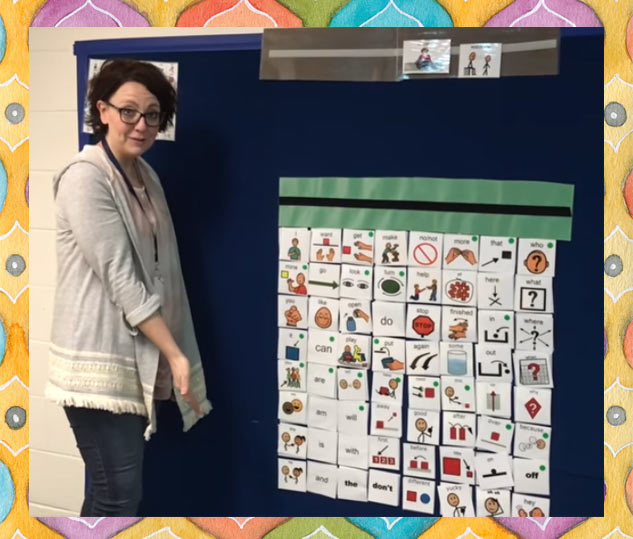


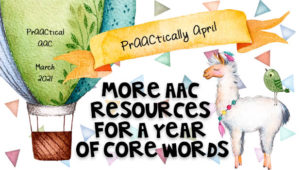
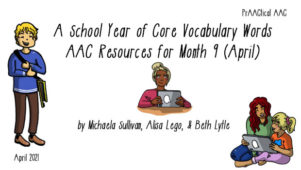

16 Comments
Very interesting. Enjoy seeing more evidence as we shift our perspective from Theme vocabuary to Core vocabulary to BIG Core vocabulary.
It was a huge shift for us too, but we have seen a ton of growth from our students. It is also really great to know that I am getting so much more academic and communication instruction in with each and every student in our classroom.
I am so excited to see all of the attention being given to this post. We have classrooms all over our county with wall sized core boards. The success just continues to support language intervention and group instruction.
We couldn’t do it without you Mar!!
We are making the shift to, very exciting! What size do you make your cards?
Oops, just watched the video again and heard 4 inches!
Yes, we find 4 inches to be a good size so that all the kiddos can see it while we instruct. Good luck! Let us know how it goes!
Love the wall sized core boards!!
We are hoping to add wall core boards to our special education classrooms. Do you happen to have a Boardmaker template saved?
Just now reading this. We have some large displays I could share. Just let me know.
Hi Marlene! I am in the process of adding BIG CORE Boards to three of my self-contained classrooms. Do you still have the large displays to share?
Thank you!
I was curious if you have any templates for the big core boards to share? I am just starting to introduce this idea in my classroom. It is so awesome!
I work with adults primarily and am so in love with this idea. I am totally putting up a core vocab board and using your ideas for shared reading in our education programs. Thank you so much for reading. I am off to watch more of your videos.
Holly, that is SO exciting! I love hearing from clinicians and educators who work with adult AAC users, particularly those who are giving these people a ‘second chance’ at language and literacy learning. So many of these clients have real potential but never got a fair shake during the school years. Would love to keep in touch with you about how things are going. 🙂
Hi Ladies,
How do you decide which CORE board to use? This year I will have six preschoolers all using different vocabulary systems (Snap + Core First, Touch Chat, Word Power 60, LAMP). I would love to do a giant CORE board for the classroom but am getting hung up on the logistics of it. Thanks for any advice you may be able to offer.
Hi!
Great site! I know Cindy’s question was almost a year ago – but I now have the same question. There are so many different set up boards out there and different apps. students are using… how did you decide which one to go with? I have one student who uses Touch Chat – so is that what I should follow for my whole classroom? I will most likely be making my own using boardmaker online – but I don’t want to confuse him.
Lastly, I know you mentioned sharing some saved templates, if still available I would love access to them to get myself started / ideas…
Thanks!